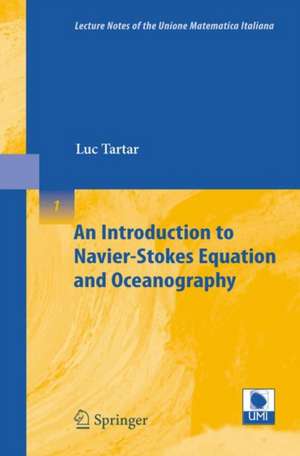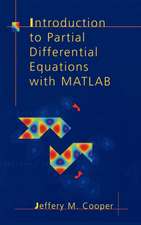An Introduction to Navier-Stokes Equation and Oceanography: Lecture Notes of the Unione Matematica Italiana, cartea 1
Autor Luc Tartaren Limba Engleză Paperback – 26 iul 2006
Din seria Lecture Notes of the Unione Matematica Italiana
-
 Preț: 432.24 lei
Preț: 432.24 lei -
 Preț: 281.43 lei
Preț: 281.43 lei -
 Preț: 418.78 lei
Preț: 418.78 lei -
 Preț: 247.82 lei
Preț: 247.82 lei -
 Preț: 346.59 lei
Preț: 346.59 lei -
 Preț: 389.70 lei
Preț: 389.70 lei -
 Preț: 356.08 lei
Preț: 356.08 lei - 15%
 Preț: 704.36 lei
Preț: 704.36 lei -
 Preț: 347.04 lei
Preț: 347.04 lei - 15%
 Preț: 525.66 lei
Preț: 525.66 lei -
 Preț: 512.27 lei
Preț: 512.27 lei -
 Preț: 390.25 lei
Preț: 390.25 lei -
 Preț: 480.62 lei
Preț: 480.62 lei - 15%
 Preț: 468.90 lei
Preț: 468.90 lei -
 Preț: 416.54 lei
Preț: 416.54 lei -
 Preț: 344.36 lei
Preț: 344.36 lei -
 Preț: 353.99 lei
Preț: 353.99 lei -
 Preț: 448.21 lei
Preț: 448.21 lei - 15%
 Preț: 584.58 lei
Preț: 584.58 lei - 15%
 Preț: 493.89 lei
Preț: 493.89 lei - 15%
 Preț: 582.95 lei
Preț: 582.95 lei -
 Preț: 350.04 lei
Preț: 350.04 lei -
 Preț: 346.97 lei
Preț: 346.97 lei -
 Preț: 390.63 lei
Preț: 390.63 lei - 15%
 Preț: 650.19 lei
Preț: 650.19 lei -
 Preț: 348.35 lei
Preț: 348.35 lei -
 Preț: 344.47 lei
Preț: 344.47 lei
Preț: 353.79 lei
Nou
Puncte Express: 531
Preț estimativ în valută:
67.71€ • 70.43$ • 55.90£
67.71€ • 70.43$ • 55.90£
Carte tipărită la comandă
Livrare economică 14-28 aprilie
Preluare comenzi: 021 569.72.76
Specificații
ISBN-13: 9783540357438
ISBN-10: 3540357432
Pagini: 276
Ilustrații: XXVIII, 247 p.
Dimensiuni: 155 x 235 x 18 mm
Greutate: 0.39 kg
Ediția:2006
Editura: Springer Berlin, Heidelberg
Colecția Springer
Seria Lecture Notes of the Unione Matematica Italiana
Locul publicării:Berlin, Heidelberg, Germany
ISBN-10: 3540357432
Pagini: 276
Ilustrații: XXVIII, 247 p.
Dimensiuni: 155 x 235 x 18 mm
Greutate: 0.39 kg
Ediția:2006
Editura: Springer Berlin, Heidelberg
Colecția Springer
Seria Lecture Notes of the Unione Matematica Italiana
Locul publicării:Berlin, Heidelberg, Germany
Public țintă
ResearchCuprins
Basic physical laws and units.- Radiation balance of atmosphere.- Conservations in ocean and atmosphere.- Sobolev spaces I.- Particles and continuum mechanics.- Conservation of mass and momentum.- Conservation of energy.- One-dimensional wave equation.- Nonlinear effects, shocks.- Sobolev spaces II.- Linearized elasticity.- Ellipticity conditions.- Sobolev spaces III.- Sobolev spaces IV.- Sobolev spaces V.- Sobolev embedding theorem.- Fixed point theorems.- Brouwer's topological degree.- Time-dependent solutions I.- Time-dependent solutions II.- Time-dependent solutions III.- Uniqueness in 2 dimensions.- Traces.- Using compactness.- Existence of smooth solutions.- Semilinear models.- Size of singular sets.- Local estimates, compensated integrability.- Coriolis force.- Equation for the vorticity.- Boundary conditions in linearized elasticity.- Turbulence, homogenization.- G-convergence and H-convergence.- One-dimensional homogenization, Young measures.- Nonlocal effects I.- Nonlocal effects II.- A model problem.- Compensated compactness I.- Compensated compactness II.- Differential forms.- The compensated compactness method.- H-measures and variants.- Biographical Information.- Abbreviations and Mathematical Notation.
Recenzii
From the reviews:
"The book has its origin in a graduate course entitled ‘Partial Differential Equations Models in Oceanography’ presented by the author at Carnegie Mellon University in 1999. … The main objective is to teach readers to have a critical point of view concerning the partial differential equations of continuum mechanics and to show the need for developing new adapted mathematical tools. … Most of the theorems and lemmas are provided in the book or a corresponding reference is given. The bibliography contains 23 items." (Jürgen Socolowsky, Mathematical Reviews, Issue 2007 h)
"The book is written by a leading expert in the field and it will certainly be a valuable enhancement to the existing literature. This is a fascinating book consisting of 42 lectures which review some classical and modern aspects of Navier-Stokes Equations (NSE). … well organized and written in a lively and provoking style. … can be recommended to applied mathematicians and theoretical geophysicists working or interested in the field as well as being an appropriate material for graduate and postgraduate courses on the subject." (Andrzej Icha, Pure and Applied Geophysics, Vol. 165, 2008)
“The book consists of 44 lectures, completed with preface, introduction, detailed description of the lectures, bibliographical information, abbreviations and mathematical notation, references, and index. … this book is … a very good exposition of the topic it is dealing with. … The course had been intended for mathematicians in the first place, in the present book form, however, it will be a welcome reading, in its larger part, also for hydrodynamicists and other researchers in the field with less specialization in functional analysis.” (Tomislav Zlatanovski, Zentralblatt MATH, Vol. 1194, 2010)
"The book has its origin in a graduate course entitled ‘Partial Differential Equations Models in Oceanography’ presented by the author at Carnegie Mellon University in 1999. … The main objective is to teach readers to have a critical point of view concerning the partial differential equations of continuum mechanics and to show the need for developing new adapted mathematical tools. … Most of the theorems and lemmas are provided in the book or a corresponding reference is given. The bibliography contains 23 items." (Jürgen Socolowsky, Mathematical Reviews, Issue 2007 h)
"The book is written by a leading expert in the field and it will certainly be a valuable enhancement to the existing literature. This is a fascinating book consisting of 42 lectures which review some classical and modern aspects of Navier-Stokes Equations (NSE). … well organized and written in a lively and provoking style. … can be recommended to applied mathematicians and theoretical geophysicists working or interested in the field as well as being an appropriate material for graduate and postgraduate courses on the subject." (Andrzej Icha, Pure and Applied Geophysics, Vol. 165, 2008)
“The book consists of 44 lectures, completed with preface, introduction, detailed description of the lectures, bibliographical information, abbreviations and mathematical notation, references, and index. … this book is … a very good exposition of the topic it is dealing with. … The course had been intended for mathematicians in the first place, in the present book form, however, it will be a welcome reading, in its larger part, also for hydrodynamicists and other researchers in the field with less specialization in functional analysis.” (Tomislav Zlatanovski, Zentralblatt MATH, Vol. 1194, 2010)
Notă biografică
Luc Tartar studied at Ecole Polytechnique in Paris, France, 1965-1967, where he was taught by Laurent Schwartz and Jacques-Louis Lions in mathematics, and by Jean Mandel in continuum mechanics.
He did research at Centre National de la Recherche Scientifique, Paris, France, 1968-1971, working under the direction of Jacques-Louis Lions for his thèse d'état, 1971.
He taught at Université Paris IX-Dauphine, Paris, France, 1971-1974, at University of Wisconsin, Madison, WI, 1974-1975, at Université de Paris-Sud, Orsay, France, 1975-1982.
He did research at Commissariat à l'Energie Atomique, Limeil, France, 1982-1987.
In 1987, he was elected Correspondant de l'Académie des Sciences, Paris, in the section Mécanique.
Since 1987 he has been teaching at Carnegie Mellon University, Pittsburgh, PA, where he has been University Professor of Mathematics since 1994.
Partly in collaboration with François Murat, he has specialized in the development of new mathematical tools for solving the partial differential equations of continuum mechanics (homogenization, compensated compactness, H-measures), pioneering the study of microstructures compatible with the partial differential equations describing the physical balance laws, and the constitutive relations.
He likes to point out the defects of many of the models which are used, as a natural way to achieve the goal of improving our understanding of mathematics and of continuum mechanics.
He did research at Centre National de la Recherche Scientifique, Paris, France, 1968-1971, working under the direction of Jacques-Louis Lions for his thèse d'état, 1971.
He taught at Université Paris IX-Dauphine, Paris, France, 1971-1974, at University of Wisconsin, Madison, WI, 1974-1975, at Université de Paris-Sud, Orsay, France, 1975-1982.
He did research at Commissariat à l'Energie Atomique, Limeil, France, 1982-1987.
In 1987, he was elected Correspondant de l'Académie des Sciences, Paris, in the section Mécanique.
Since 1987 he has been teaching at Carnegie Mellon University, Pittsburgh, PA, where he has been University Professor of Mathematics since 1994.
Partly in collaboration with François Murat, he has specialized in the development of new mathematical tools for solving the partial differential equations of continuum mechanics (homogenization, compensated compactness, H-measures), pioneering the study of microstructures compatible with the partial differential equations describing the physical balance laws, and the constitutive relations.
He likes to point out the defects of many of the models which are used, as a natural way to achieve the goal of improving our understanding of mathematics and of continuum mechanics.
Textul de pe ultima copertă
The Introduction to Navier-Stokes Equation and Oceanography corresponds to a graduate course in mathematics, taught at Carnegie Mellon University in the spring of 1999. Comments were added to the lecture notes distributed to the students, as well as short biographical information for all scientists mentioned in the text, the purpose being to show that the creation of scientific knowledge is an international enterprise, and who contributed to it, from where, and when. The goal of the course is to teach a critical point of view concerning the partial differential equations of continuum mechanics, and to show the need for developing new adapted mathematical tools.
Caracteristici
Includes supplementary material: sn.pub/extras











